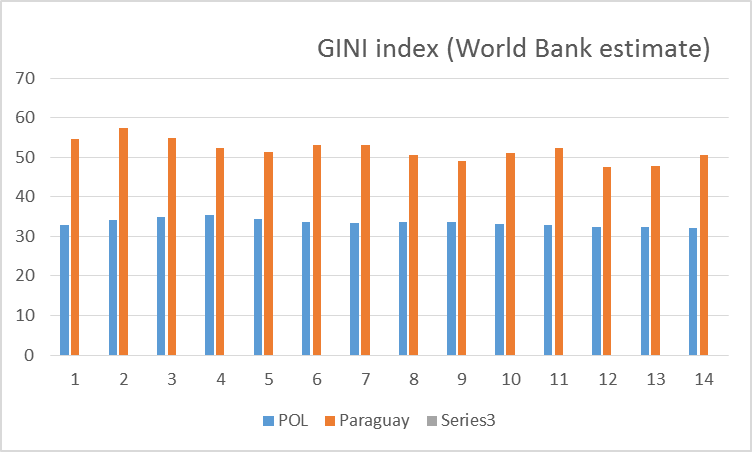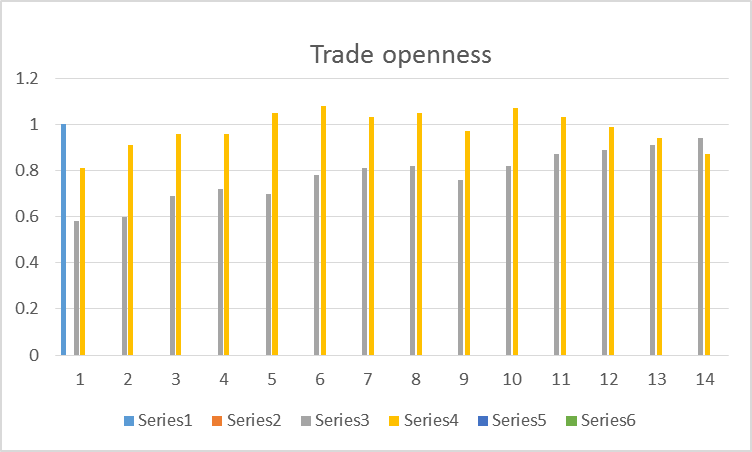Introduction
In this current report, we will be taking out the correlation between the GINI index and the Openness of two countries namely Poland and Paraguay. Then there would also be included Stolper-Samuelson theorem which tells about the relative price of the product with its price of another factor of production.
Question
Report and interpret the relationship between Openness and the GINI Index for each nation.
The correlation of the coefficient of both the countries by taking two variables namely openness and the GINI index of Paraguay and Poland. It was done by taking the CORREL function in an Excel sheet by putting both variables into there. The correlation is of two types namely -1 and +1 and they both denote having positive or negative relationship between the variables which are to be taken. The -1 would be telling that both the variables have a negative relationship like both variables have inverse relationships between them. On the other hand, if they have +1 this would mean that they have having positive or most possible relationship between them. In this, if one is increasing the other one would also be increasing and if one is decreasing other would also be decreasing (Stockhammer, 2017).
Need to Consult Directly With Our Experts?
Contact UsSo when there was a correlation that was taken of both Openness and the GINI index the relationship was taken out to be +1. This would clearly denote that if the GINI index of Poland would be increasing then the Openness of Poland would also be increasing and vice versa. The same is the case with Paraguay if one is decreasing other one would also be decreasing an equal amount.


Question 2:
Explain the Stolper-Samuelson theorem.
During the time within any kind of industry if economic profits are zero and there is a positive relationship between production what would be the change in the level of output if the price of factors are affected that is either they are increased or decreased? Then after this, there would be analysed the impact on income of factors of production when the country is moving from self-sufficient towards free trade and even at that time when they are imposing tariffs under the Heckscher-Ohlin theory (Khemili and Belloumi, 2018). In this case, there is always the assumption of perfect competition within markets and production is also occurring in the industry at this time the profit would be reaching 0 this is known as Stolper- Samuelson theory.
Like in this case where there are two products which are steel and clothing and labour are getting their respected wages and the producer is also paying rent on capital. So the relationship between relative prices with of other factors of production like that of rental rates of capital and real wages of labourers would be included in this theory.
Also, you can get our online coursework help to excel in your studies and achieve academic success.
Question 3:
Explain whether data agree or disagree with the Stolper-Samuelson theorem.
In this part, it is to be assumed that both Poland and Paraguay are unskilled labour-abundant countries which means that both nations are producing only labour-intensive products and exporting them. While on the other hand, both of them are not producing any capital-intensive products and they are importing them from other nations. This means that labour would be more mobile and training could be there for them and they are supposed to earn wages in return for the service provided (Chaudhuri and Biswas, 2018). So in both these countries, there are workers but they are all unskilled so this would not certainly hurt any other country or their workers which was included in the Stolper-Samuelson theorem.
It was argued in this theory that if they are removing all sorts of tariffs on labour-intensive goods then this would intern be depressing wages than the price of products. the correlation between the GINI index and the openness of the economy of Poland and Paraguay was +1 which shows that if wages increased this would lead to more production and thus the country would be able to trade with other countries of the world.
Get our professional assignment writing service from the experts!
Also Read: Business Strategy of SeaWorld
References
- Chaudhuri, S. and Biswas, A., 2018. External terms-of-trade and labour market imperfections in developing countries: Theory and evidence. Indian Growth and Development Review, 11(1), pp.22-33.
- Khemili, H. and Belloumi, M., 2018. Cointegration Relationship between Growth, Inequality and Poverty In Tunisia. International Journal of Applied Economics, Finance and Accounting, 2(1), pp.8-18.
- Stockhammer, E., 2017. Determinants of the wage share: A panel analysis of advanced and developing economies. British Journal of Industrial Relations, 55(1), pp.3-33.


 Company
Company













